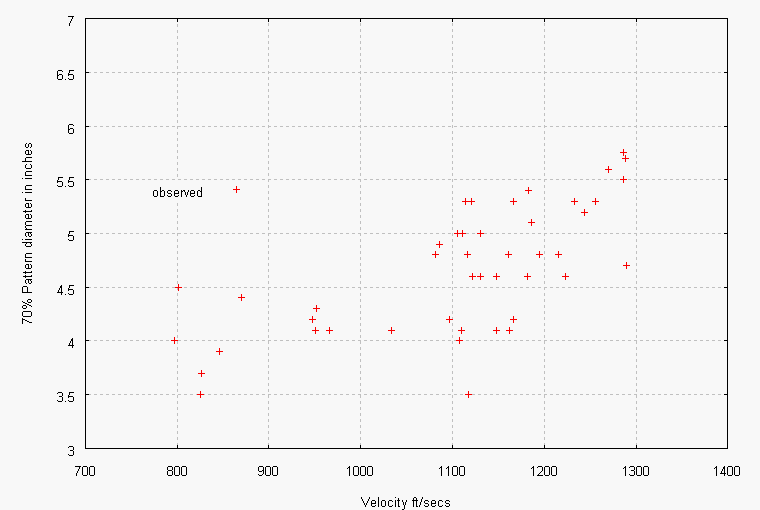
Velocity vs. Pattern size.
Myth - Too fast a shell will blow your pattern - whatever that means.
I take this to mean --Your pattern increases with an increase in velocity.
This myth has been around forever with little or no proof. This should be an easy thing to test so first I'll test to see if it is true. Then if it is true I'll try to see how important the relationship really is. Here I would also hope to determine if pattern variation caused by velocity is important enough for me to take it into consideration when choosing a load.
Process:
1. Shoot and collect patterns and velocities from shells with varying velocities.
2. Evaluate and calculate 70 % circle diameters by count.
3. Run simple statistics on tabulated results to test hypothesis
4. Try to get a statistically significant relationship between velocity and pattern size.
5. Draw conclusions.
Technical precautions and procedures:
1. Eliminate as many variables as possible.
c. Same distance - 14 yards (see earlier discussion on pattern evaluation).
2. Vary velocities.
Quick look at data:
Below is a graph of velocity vs. 70% pattern size. I have included all shells and the resulting patterns no matter how bad they might appear.
Several of these were anomalies due to wad influence or whatever. In these some ended up really tight and others very wide and generally out of sync with others built with the same powder charge. However for statistical analysis I included everything.
Chart of data (14 yd 70% pattern size vs. velocity)
If You have trouble seeing this graph click on the graph itself.
Statistics:
Running a simple multiple linear regression program against the data we can see if velocity is significant in determining pattern size. We can also see if changing the wads has had a significant an impact on the pattern size.
Where variable 1 being pattern size, 2 being velocity and 3 being cb1100-12 wad inclusion. A 4th variable shows up in the results and is a constant term.
VARIABLE MEAN VARIANCE STD DEV 1 4.652223 .3468089 .5889049 2 1103.511 19390.21 139.2487 3 .4444444 .2525252 .5025189 MATRIX OF SIMPLE CORRELATION COEFFICIENTS 1 1 2 .6819 1 3 -.5564 -.7296 1 DEPENDENT VARIABLE NO. 1 .1915719 8.046021 42 VARIABLE COEFFICIENT STD.ERROR T-VALUE 2 2.495218E-03 6.928503E-04 3.601381 3 -.1475711 .1919899 -.76864 4 1.964335 .8314409 2.362567 MEAN SQUARE STD ERROR MULT CORR F-TEST ON R .1915719 .4376893 .6875491 18.82732
From this analysis we see that velocity (variable 2) is significant in predicting pattern size as is variable 4 (a constant) but wad (variable 3) had no statistical impact. Significant is determined by a T-value of greater than 2 or less than -2 in the results for this variable in predicting pattern size. So by removing the wad variable I should get a better estimate of the influence of velocity. So eliminate wad variable and rerun.
Here variable 1 is still pattern size and variable 2 is velocity. The third variable being the constant term.
VARIABLE MEAN VARIANCE STD DIV 1 4.652223 .3468089 .5889049 2 1103.511 19390.21 139.2487 MATRIX OF SIMPLE CORRELATION COEFFICIENTS 1 1 2 .6819 1 DEPENDENT VARIABLE NO. 1 .1898222 8.162354 43 VARIABLE COEFFICIENT STD.ERROR T-VALUE 2 2.883746E-03 4.71689E-04 6.11366 3 1.469988 .5245504 2.802377 MEAN SQUARE STD ERROR MULT CORR F-TEST ON R .1898222 .4356859 .6819826 37.38889
Chart with regression line drawn in:
If You have trouble seeing this graph click on the graph itself.

These results indicate that speed has a significant impact on pattern size at least for this gun and type loads tested.
An estimate would be for any given velocity would be:
14 yd 70% pattern size = 1.47 + .00288 * velocity
A 40-yard pattern size is roughly 5 times a 14-yard pattern size. To calculate my expected 40 yard pattern size multiply this result by 5. Remember this result is for my test gun with a .40 constriction which is fairly tight.
For an 1150 f/s shell the expected pattern size would be 1.47+.00288*1150=4.782 *5=23.91 inch circle at 40 yards and for a 1250 shell this increases to 25.35.
Note: This is for the inclusion of all shots. I have not averaged the shells and have not selectively thrown out obvious outlyers. A much better estimate at actual spread expected for a given increase velocity can be determined by being more selective in which shots I use in the model and averaging groups etc.
Conclusions:
Pattern size does increase with velocity and it seems very significant.
A 300 f/s increase will result in about a 4 to 5 inch greater spread at 40 yards. This equates to about changing from a full choke to a modified.
Real eye opener:
A rough look at the data might lead one to conclude that the relationship is more geometric than linear as velocity gets very fast. This would mean that velocity is even more important than indicated. But thatís another research project.
The unexpected wide range and variation of observed pattern sizes while shooting in a very controlled environment with very controlled loads. This seems to be an area that needs further research. What causes and how to better control.